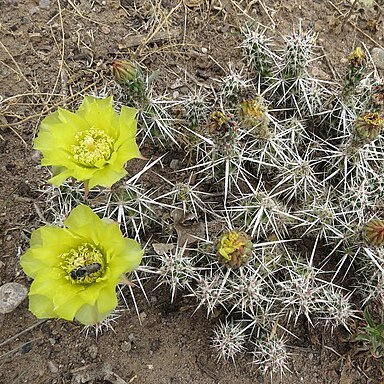Shrubs, forming mats, widely spreading, 5-15 cm, in series of usually 1-2 stem segments. Roots diffuse. Stem segments short-clavate, strongly narrowed at base, 2.5-5(-7.5) × 1.5-3 cm; tubercles prominent, oval, 5-10(-16) mm, narrow, 4-6 times longer than wide, obscured by interlacing spines; areoles 3 mm in diam.; wool white to gray. Spines 7-15 per areole, primarily in distal areoles; major 3-5 abaxial spines deflexed, white, flattened, longest central spine daggerlike, broadly tapered, 12-35 × 1.5+ mm basally; major 1-3 adaxial spines ascending, white, yellow to tan, angular-flattened to subterete. Glochids in adaxial 1/4 of areole, yellowish white, ± 4 mm. Flowers: inner tepals bright yellow, to 25 mm; filaments light yellow-green to white; style and stigma lobes white. Fruits yellow, barrel-shaped to ellipsoid, 30-45 × 15-25 mm, fleshy, spineless, densely ± yellow-glochidiate; areoles 35-55. Seeds yellowish white, 4.5 × 4 mm, smooth. 2n = 22.
More
A cactus which forms clumps. The stems are 7 cm long and 2-3 cm wide. It is oval in shape. There are barbed bristles and spines. The spines are white. About 10 radiate and are 1.5 cm long and 4-8 in the centre are 3 cm long. The flowers are golden yellow. They are about 4 cm long. The fruit are barrel shaped and yellow. They are fleshy and 3-4.5 cm long by 1.5-2.5 cm wide.
Grasslands, sandy soils, and in xerophyllous scrub and juniper forest; at elevations from 1,800-2,500 metres.
More
It needs bright light. It needs a temperature above 7°C. It suits hardiness zones 9-11.


